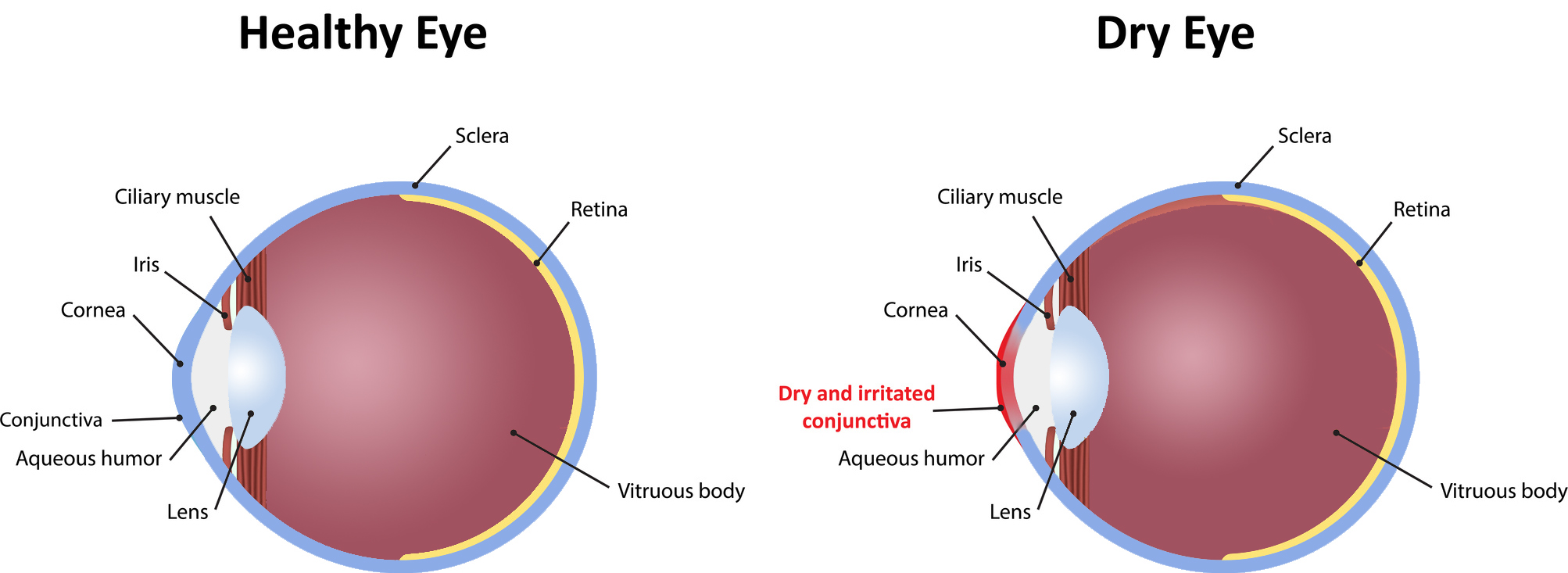Dry eye happens when your tears do not provide enough lubrication for your eyes. Tears are important in keeping your eyes clear, healthy and comfortable. They keep the surface of your eyes moist and wash away dust or any foreign matter in the eye, reducing the risk of eye infection.
Causes
Tears have three layers – oily layer, watery layer, and mucus layer. Each of these layers has a purpose. The oily layer prevents tears from evaporating or drying up too quickly; the water layer lubricates the eye and washes away the particles in the eyes; and the mucus layer spreads the watery layer over the surface of the eye evenly, helping the tears stick to the surface of the eyes. If there is a problem in any of these layers, such as not being able to produce enough water, oil or mucus, it can lead to dry eyes.

There are different reasons one can have dry eyes:
- Aging – while it can occur at any age, it becomes more common when you are over 50 years old.
- Computer use or any near work activity – when doing near work activities like using the computer or a gadget or reading a frequently, causing the tears to dry up more quickly
- Indoor environment – electric fans and air conditioning can decrease indoor humidity, which makes tears to hasten tear evaporation
- Outdoor environment – having dry climates or windy condition puts one at higher risk for dry eyes
- Smoking – it has been linked to several eye conditions like cataract, macular degeneration and even dry eyes
- Eyelid problems – eyelids that do not fully close when blinking or sleeping can lead to severe dry eyes
- Medications – certain prescription and non-prescription medicines like anti-histamines, beta blockers and birth control pills can increase one’s risk for dry eyes
Other potential causes include menopause, contact lens wear, LASIK and allergies.
Signs and Symptoms
While it is not usually a serious eye condition, it may lead to discomfort. It usually affects both eyes and may cause:
Burning or stinging sensation in the eyes
Blurred vision
Red, scratchy or itchy eyes
Sensitivity to light
Watery eyes/tearing
Treatment
The treatment for dry eyes depends on what is causing it. The goal is to relieve the symptoms and keep your eyes healthy:
- Lubricating eye drops – the most common treatment, these are also called artificial tears. It is the mainstay treatment for dry eye, aimed to help your eyes feel more comfortable
- Prescription eye drops – aside from lubricating the surface of the eyes, it helps your eyes make more tears, and reduce swelling
- Punctal plugs – used to keep the tears on the surface of the eye longer, a small, sterile device is inserted in the opening of the tear ducts. This device is removable.
- Surgery – certain eyelid conditions can lead to dry eyes. Consult with an oculoplastics/eye plastic surgeon to correct this eyelid problem.
- Lifestyle changes – what medicine are you taking? Do you smoke? How much water do you drink? Are you always exposed to smoke or air-conditioning? Do you sleep 7 to 8 hours a night? Consult with your doctor to know what is causing your dry eyes or making it worse. He/she will then recommend you to make adjustments to protect your eyes.
- Blephex – a quick and painless 10-minute outpatient procedure used to clean the eyelids, it makes use of a revolutionary handpiece that safely and effectively eliminates the bacterial film and oil on the eyelids. It will feel like having a massage on your eyelids, but it promotes relief and improvement from the dry eye symptoms.

